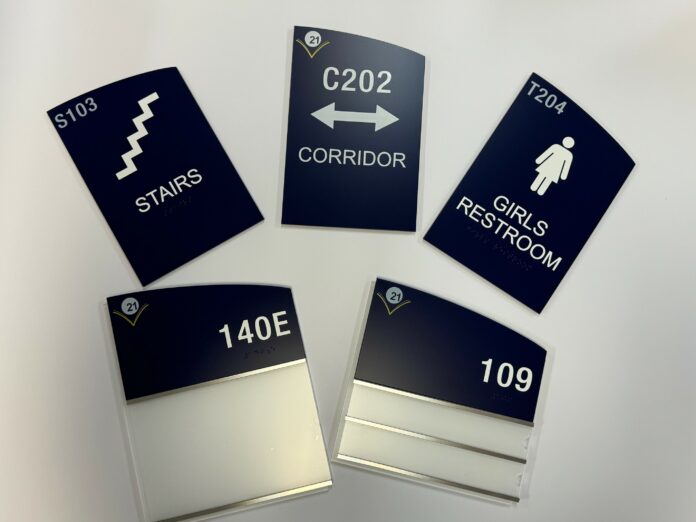The Americans with Disabilities Act (ADA) comes with extensive requirements to ensure access for all users—not just to physical facilities but also to the information they need to be fully served. Signage is a critical element of accessibility, and if your shop is known as an expert in compliance, your skill and knowledge will keep customers coming back for ADA signage and other projects too.
Our industry does a great job of meeting needs in the ADA space, and new printing technologies are making entry into production easier. Consumers have become more aware as well. They usually don’t have to be told about ADA regulations and just want help complying; it’s already in their minds.
But we do see examples of non-conforming signs or products that are overly elaborate and expensive when something simpler would do. It’s an indication that we need to educate ourselves about the law and a reminder that close attention to detail is always necessary.
Learning the Law
Getting to know the requirements is relatively easy; they are available online at the ADA website’s signage section: ada.gov/law-and-regs/design-standards/2010-stds/#703-signs.
Generally, the rules specify that materials be visible and accessible, with requirements governing things like their dimensions, fonts, character sizes, where and how signs can be mounted, graphic elements, and Braille or raised characters that visually impaired users can understand.

Much of what is required is based on interpretation of the rules in some cases, but the risk of misinterpretation can be mitigated by involving the client in decisions as well as knowing the actual risk is low if you make a good-faith effort to follow regulations. One rule, for example, is that every “permanent use” of a room requires a tactile ADA sign. What is permanent use? It’s hard to say. Restroom and elevator mechanicals are easy to identify as permanent, but a conference room could be turned into an office. That’s a gray area where you and the client may need to seek the counsel of an ADA attorney.
Challenges can come from clients who don’t understand the law, but also from your own team. Graphic designers often want some sign elements to be “invisible” for aesthetic reasons. Designers often struggle to accept the ADA’s mandates on contrast level, matte finish, spacing around the raised graphics and use of non-serif fonts. The law requires that everything be plain and direct. Work closely with your design team; bring them into the project and walk them through the requirements. If a designer manages to get the client’s ear and convinces them to do something non-compliant, document that on the proofs.
Possibilities and Challenges
There are always burgeoning opportunities in this specialty. Once you’re comfortable with creating ADA signage, you can find the work leading to more and bigger projects. For example, suppose you’ve established a small relationship with someone in construction who just needs bathroom and basic occupation requirements. You now have your foot in the door for expanding the relationship with related owners, designers and architects who do business with that construction company. A small occupancy need can turn into branding, wayfinding and more.
Multi-unit residential communities can be another expanding market for you. Government work requires some legwork, but pays massive dividends with repeat business and high-quality product requirements.

Four Tips for Effective and Compliant ADA Signage
- Educate yourself: Be well read on the topic. Contact other sign companies for guidance if needed. Make sure your staff also knows the requirements and be a patient and persistent teacher in guiding them.
- Document everything: As with any project, your clients may not do as you suggest, so always document your recommendations. It’s even more important with ADA compliance, since failure to adhere to the law can result in a fine or other penalty.
- Ask for help if you need it: In a situation of high risk, like a large package of 75 or more signage pieces, you can suggest your client consult with an ADA attorney. They won’t see you as uncertain but will appreciate your wanting the work to be absolutely correct. I’ve only done this once in 21 years in the ADA business, but it was nice to have another expert at my back.
- Don’t risk non-compliance for price or speed: Poor quality often results when companies try to be price sensitive. They end up making something that’s flimsy or looks horrible. Make a good-quality product, one that’s durable, easy to use and attractive. And don’t be afraid to charge what it takes to make the right sign.
A Rewarding Specialty
ADA signage can be a wonderful segment of your business. It can help you establish long-term clients and serve as a buffer against the fluctuations of business. It’s been both a steady flow of repeat and new business and an occasional spike in revenue from clients with big one-time-only projects.
You’re also helping to make a difference for people who just need a little assistance.
Maggie Harlow is the Owner of Signarama Downtown in Louisville, Kentucky. She manages the full-service sign company, offering her expertise in illuminated signage, large format digital printing, custom signs, vinyl graphics, banners, trade show displays and more.











